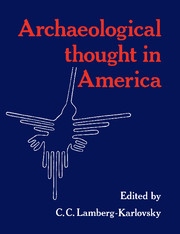Book contents
- Frontmatter
- Contents
- List of illustrations
- Introduction
- Part I History, method, and theory
- Part II Archaeology in the Americas and beyond
- 9 The structural analysis of Paleolithic art
- 10 Ancient China and its anthropological significance
- 11 Settlement pattern studies and evidences for intensive agriculture in the Maya Lowlands
- 12 The political economy of the Inka empire: the archaeology of power and finance
- 13 An epigenetic view of the Harappan culture
- 14 The use and abuse of world systems theory: the case of the “pristine” West Asian state
- 15 Mesopotamia, Central Asia and the Indus Valley: so the kings were killed
- 16 New tracks on ancient frontiers: ceramic technology on the Indo-Iranian Borderlands
- 17 Pastoralism and the early state in Greater Mesopotamia
- References
- Index
16 - New tracks on ancient frontiers: ceramic technology on the Indo-Iranian Borderlands
Published online by Cambridge University Press: 06 July 2010
- Frontmatter
- Contents
- List of illustrations
- Introduction
- Part I History, method, and theory
- Part II Archaeology in the Americas and beyond
- 9 The structural analysis of Paleolithic art
- 10 Ancient China and its anthropological significance
- 11 Settlement pattern studies and evidences for intensive agriculture in the Maya Lowlands
- 12 The political economy of the Inka empire: the archaeology of power and finance
- 13 An epigenetic view of the Harappan culture
- 14 The use and abuse of world systems theory: the case of the “pristine” West Asian state
- 15 Mesopotamia, Central Asia and the Indus Valley: so the kings were killed
- 16 New tracks on ancient frontiers: ceramic technology on the Indo-Iranian Borderlands
- 17 Pastoralism and the early state in Greater Mesopotamia
- References
- Index
Summary
Over the past several decades, the study of production and exchange has taken a central place in research on the development of complex societies (Sabloff and Lamberg-Karlovsky 1975; Johnson 1973; Wright 1972; Earle and Ericson 1977; R. McC. Adams 1974a; Kohl 1978; Hirth 1984). These studies have been a welcome corrective to the anti-diffusionist views that had dominated anthropology and archaeology, in that they have shown that aspects of diffusion are a powerful force in generating cultural change. By focusing on production and exchange as they ramify on institutional structures (Adams 1974a: 240), they have made significant progress toward refining our understanding of their relationship to different socioeconomic settings.
This chapter falls within the above tradition, but it does so from a broadened perspective. First, I have used the term “exchange” in preference to “trade” since it encompasses a wider range of institutional settings than is presumed by trade. In particular, it leaves open the question of whether exchange relations are aligned with political, social or economic institutions. Second, I have distinguished between two types of diffusion: (1) the exchange of material goods and (2) the transmission of technical knowledge. By technical knowledge I refer to the steps taken in producing a product as they are discernible from archaeological materials; and by its transmission, the sharing of a particular technology within and between cultural groups. Although the two – exchange of material goods and transmission of technical knowledge – are obviously related, analytically separating them allows one to trace their shifting relations.
- Type
- Chapter
- Information
- Archaeological Thought in America , pp. 268 - 279Publisher: Cambridge University PressPrint publication year: 1989
- 6
- Cited by



